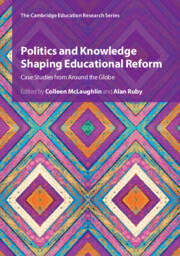Book contents
- Politics and Knowledge Shaping Educational Reform
- Politics and Knowledge Shaping Educational Reform
- Copyright page
- Contents
- Figures and Tables
- Contributors
- Preface
- 1 Introduction
- 2 Radical Curriculum Change and the Politics of ‘Implementation’
- 3 Towards a Play-Based Pedagogy in Ghanaian Kindergarten Education
- 4 Implementing Fee-Free Education in Rwanda
- 5 Policy Implementation in a Sisyphean State
- 6 Reforming the School System
- 7 Educational Reform in Scotland
- 8 The Role of Textbooks in Improving Education in Portugal
- 9 Turning Social Capital into a Working Wage
- 10 High-Performance and Equity
- 11 Missing Opportunity?
- 12 Conclusion
- Index
- References
7 - Educational Reform in Scotland
Policy, Governance and Professional Culture
Published online by Cambridge University Press: 06 February 2025
- Politics and Knowledge Shaping Educational Reform
- Politics and Knowledge Shaping Educational Reform
- Copyright page
- Contents
- Figures and Tables
- Contributors
- Preface
- 1 Introduction
- 2 Radical Curriculum Change and the Politics of ‘Implementation’
- 3 Towards a Play-Based Pedagogy in Ghanaian Kindergarten Education
- 4 Implementing Fee-Free Education in Rwanda
- 5 Policy Implementation in a Sisyphean State
- 6 Reforming the School System
- 7 Educational Reform in Scotland
- 8 The Role of Textbooks in Improving Education in Portugal
- 9 Turning Social Capital into a Working Wage
- 10 High-Performance and Equity
- 11 Missing Opportunity?
- 12 Conclusion
- Index
- References
Summary
This chapter takes as its starting point the features identified as critical in understanding the process of educational reform, set out by McLaughlin and Ruby in their review of the case studies in Implementing Educational Reform: Cases and Challenges. These are: the historical and political context; models of implementation; timescale; internal and external actors; communication and discourse. It examines the relationship between structure and culture in promoting successful change in educational systems focusing particularly on the role of external actors in shaping the Scottish Government’s management of change and the tension between the broad curricular intentions and the narrow conception of assessment in upper secondary school. It also examines the extent to which governance reform is capable of enabling sustained cultural change; and the best means of encouraging teachers to develop a sense of agency, not simply the implementers of policy devised by external ‘experts’. It illustrates how educational reform in Scotland is complex, contested territory in which the policy intentions of government are interpreted and mediated through bureaucratic agencies, professional networks and an expanding field of interest and pressure groups.
- Type
- Chapter
- Information
- Politics and Knowledge Shaping Educational ReformCase Studies from Around the Globe, pp. 99 - 114Publisher: Cambridge University PressPrint publication year: 2025

